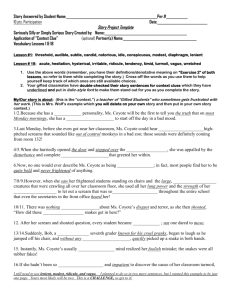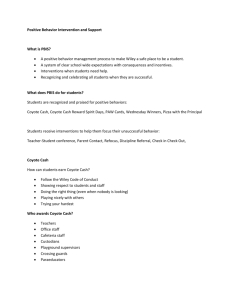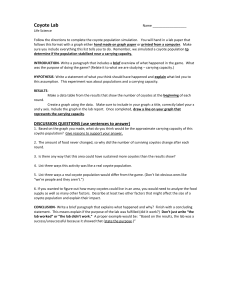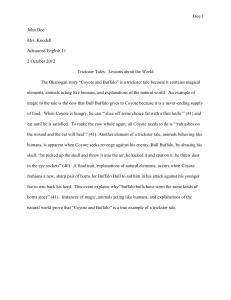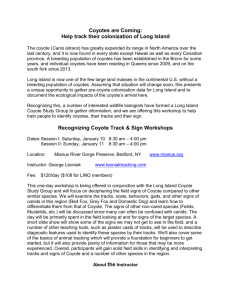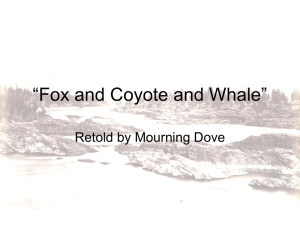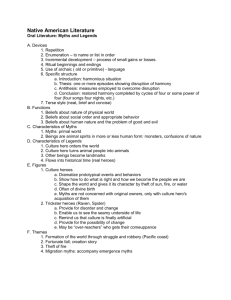Word - Unitarian Universalist Association
advertisement
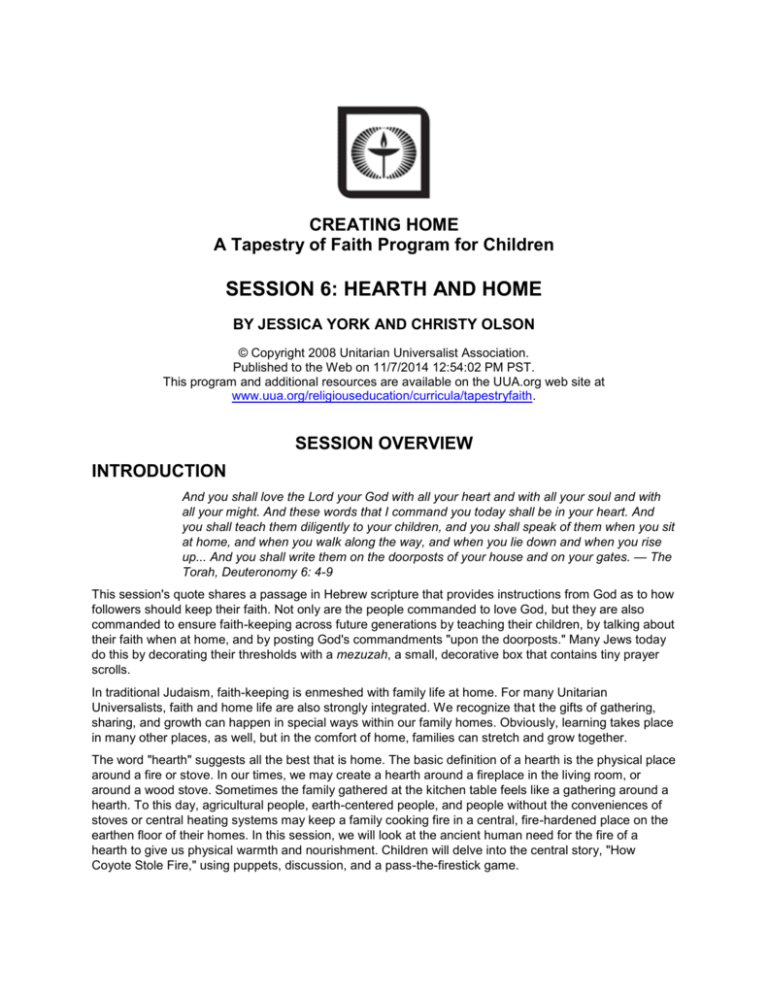
CREATING HOME A Tapestry of Faith Program for Children SESSION 6: HEARTH AND HOME BY JESSICA YORK AND CHRISTY OLSON © Copyright 2008 Unitarian Universalist Association. Published to the Web on 11/7/2014 12:54:02 PM PST. This program and additional resources are available on the UUA.org web site at www.uua.org/religiouseducation/curricula/tapestryfaith. SESSION OVERVIEW INTRODUCTION And you shall love the Lord your God with all your heart and with all your soul and with all your might. And these words that I command you today shall be in your heart. And you shall teach them diligently to your children, and you shall speak of them when you sit at home, and when you walk along the way, and when you lie down and when you rise up... And you shall write them on the doorposts of your house and on your gates. — The Torah, Deuteronomy 6: 4-9 This session's quote shares a passage in Hebrew scripture that provides instructions from God as to how followers should keep their faith. Not only are the people commanded to love God, but they are also commanded to ensure faith-keeping across future generations by teaching their children, by talking about their faith when at home, and by posting God's commandments "upon the doorposts." Many Jews today do this by decorating their thresholds with a mezuzah, a small, decorative box that contains tiny prayer scrolls. In traditional Judaism, faith-keeping is enmeshed with family life at home. For many Unitarian Universalists, faith and home life are also strongly integrated. We recognize that the gifts of gathering, sharing, and growth can happen in special ways within our family homes. Obviously, learning takes place in many other places, as well, but in the comfort of home, families can stretch and grow together. The word "hearth" suggests all the best that is home. The basic definition of a hearth is the physical place around a fire or stove. In our times, we may create a hearth around a fireplace in the living room, or around a wood stove. Sometimes the family gathered at the kitchen table feels like a gathering around a hearth. To this day, agricultural people, earth-centered people, and people without the conveniences of stoves or central heating systems may keep a family cooking fire in a central, fire-hardened place on the earthen floor of their homes. In this session, we will look at the ancient human need for the fire of a hearth to give us physical warmth and nourishment. Children will delve into the central story, "How Coyote Stole Fire," using puppets, discussion, and a pass-the-firestick game. While participants explore the literal hearth, a broader concept of "hearth" also informs this session. The Merriam-Webster online dictionary offers an alternate definition of the word : (at www.merriamwebster.com/dictionary/hearth) "a vital or creative center." The activities will help children identify the relationships, feelings, and learning they find in the vital, creative center that their own family home provides. As this session explores the experience of gathering in a family home, negative emotions may arise for some children. In some homes, children feel the absence of a parent who travels frequently. Some participants may harbor complex feelings about gathering with each of two parents in separate homes after a divorce. Be careful not to imply that all family homes always are, or always should be, full of warmth. Listen attentively and without judgment to each child's comments. This session may spark some children to disclose information about a potentially dangerous situation in their home. You need to listen carefully. If you feel a child needs to share information about his/her home that is sensitive, complete your conversation with that child apart from the group. At any time, if you are unsure how to respond to a child's disclosure or how to handle family information he/she shares, talk with your religious education director. Particularly, remember you are responsible to convey relevant information to your religious education director or minister to ensure that the safety policies of your congregation and your state are followed. GOALS This session will: Explore how the act of gathering together unites the members of a family home Demonstrate how good relationships within our homes help us work and learn together Explore the relationships between humans and animals Engage participants in an investigation of why warmth is an important part of family and faith homes LEARNING OBJECTIVES Participants will: Make a hearth to take home Hear a Native American story of Coyote and fire that emphasizes the warmth needed by all humans Retell the story, using puppets Learn "This Little Light of Mine," Hymn 118 in Singing the Living Tradition Explore flames Participate in a relay that emphasizes working together Optional: Participate in an activity that joins their faith with aid to animals Related content: Singing the Living Tradition (at http://www.uuabookstore.org/productdetails.cfm?PC=565) SESSION-AT-A-GLANCE ACTIVITY MINUTES Opening 5 Activity 1: A Home Hearth 25 Activity 2: Story — How Coyote Stole Fire 5 Activity 3: Making Coyote Finger Puppets 15 Activity 4: Singing "This Little Light of Mine" 5 Faith in Action: Helping the Humane Society — Long-term 10 Faith in Action: Blessing the Animals — Long- or Short- term 20 Closing 5 Alternate Activity 1: Candlestick Fruit Salad 10 Alternate Activity 2: Clay Animals 15 Alternate Activity 3: Fire Stick Relay 15 SPIRITUAL PREPARATION To prepare yourself spiritually for this Creating Home journey, sit in a comfortable position on the floor or in a chair. Close your eyes and think about a time you sat in front of a fireplace or a campfire. If you have had few experiences with an open fire, you may want to light a candle and look at the flame while you consider these questions. Think about the colors of the flames in a fire. How do they change? Think about the warmth of the fire. Does this warmth permeate your whole being? When you are warmed by a fire, are you more receptive to new ideas? As the flame continually changes, do you feel pressured by the changes? Now think about food. Think about the nourishment of warm milk, or your favorite soup. These foods were warmed by the heat of a stove, oven or microwave, which are sources of warmth in today's kitchens. How does warm food restore your equilibrium? Lastly, think about where your family gathers in your home. Is the kitchen a place of warmth and cooking or a place of gathering? Why, or why not? Open your eyes. Stretch and embrace all that this session has to offer. SESSION PLAN OPENING (5 MINUTES) Materials for Activity Chalice candle or LED/battery-operated candle Lighter or matches Labyrinth Basket of name stones Newsprint, markers, and tape Preparation for Activity Write the chalice-lighting words on newsprint, and post. Memorize the chalice-lighting words so you can make eye contact with participants while you say them. Spread the labyrinth on the floor with the chalice in the center. Place the basket of stones on top of the labyrinth. Description of Activity As children enter, invite them to retrieve their name stones from the basket and join you at the labyrinth. Be aware of guests or newcomers. Always have extra stones so you can offer the new people a chance to be part of the ritual. When all are seated, light the chalice and recite these opening words. Invite everyone to recite with you: We are Unitarian Universalists, with minds that think, hearts that love, and hands that are ready to serve. In these words or your own, say: This labyrinth reminds us that we are taking a journey together. Every session is yet another portion of that journey. Each time we meet, everyone will be asked to place his or her stone within the labyrinth. Each stone is a symbol of us as fellow members of this Creating Home community. Please say your name and share any joys or concerns you have had since we last met. Joys are the things that make you feel happy and concerns are worries. Sharing our joys and concerns with each other is a tradition in our faith community. Allow children, one at a time, to step onto the labyrinth, speak their joys and concerns, place their stones, and return to the circle. Thank each participant. Ask the children how it feels to gather around a common place, as they are doing together now in Creating Home. Ask if they ever gather at a place at home. If no answers are forthcoming, ask specifically about in the kitchen, around a table where people eat together, or even in front of a television. Tell the children that in today's session, they will talk about gathering around a place in a family home. Extinguish the chalice. ACTIVITY 1: A HOME HEARTH (25 MINUTES) Materials for Activity Bag(s) of powdered plaster of Paris Plastic tarp to cover floor Wooden paint stirrers for mixing plaster of Paris Large plastic containers with tight lids Plastic measuring cups from ground coffee or powdered laundry detergent Aluminum pie tins for all participants A permanent marker Votive candle holders or tea lights for all participants Stones for participants to decorate their "hearths" Preparation for Activity Purchase plaster of Paris, enough to mix wet plaster to fill each child's pie tin a third full. Obtain plastic sheeting or non-porous drop cloths. Use these to cover the work area. Obtain several plastic buckets that have tight-fitting lids such as ice cream or food storage containers; wooden paint stirrers; and plastic scoops such as those found in cans of ground coffee and boxes of laundry detergent. Obtain enough aluminum pie tins and votive candle holders or tea lights for all participants, and an assortment of stones to decorate "hearths." Shortly before your session, mix plaster of Paris with water in the plastic container(s) by following the package instructions. Cover the container(s) tightly and store the wet plaster at room temperature. Description of Activity Ask if any of the children have ever heard of a hearth. Allow responses. Then, say in your own words: Long ago a hearth was the place in a home where people kept a fire burning, sometimes all day and all night. The fire was used for cooking and staying warm. It was the place where people in a family would naturally gather. Do any of you have something like that, where you live now? Do you have a hearth in your family home? Participants may offer, or you may suggest, a kitchen stove, a fireplace, a wood stove, a dining room table with candles lit for dinner, or an electric heater. Tell the group that even if their family home doesn't have a hearth, they will be able to gather with people in their home around the hearth they'll make today. Say, in your own words: Today you will make an old-fashioned kind of hearth, a hearth like those made by Earthcentered peoples since ancient times. Earth-centered people lived in harmony with nature; they gathered or grew all their food from nature, made all their homes from what they gathered from nature, and honored the spirit of life that they believed was in all natural beings and things. Earth-centered cultures have for centuries created home hearths by compacting earth or using stone rings. The home hearth was a place for cooking, gathering, warmth and family life. The hearth was usually centered in the structure so that smoke from the fire rose through an opening in the roof or top of the structure. People often added stones around their hearths. Write each child's name in permanent marker on the bottom of an aluminum pie tin. Distribute the pie tins, and demonstrate how to fill a pie plate one third full with the pre-mixed plaster, using a plastic measuring cup. As children fill their pie tins with plaster, distribute the votive candle holders or tea lights. Invite participants to place theirs firmly into the plaster in the middle. Provide the stones you have brought, and allow participants to choose a few to press into the plaster, deep enough so the plaster will harden around them. "Hearths" may not be completely dry when your session ends, but they will dry overnight. Encourage children to put the hearth in a central place in their family homes, a place where family members gather, such as a table where people eat together. You may mention to parents when they pick up their children that they can light a flame in their home hearth during times of gathering. The Taking It Home section for this session also mentions the hearth. ACTIVITY 2: STORY — HOW COYOTE STOLE FIRE (5 MINUTES) Materials for Activity A copy of story, "How Coyote Stole Fire" (included in this document) Optional: A plaster of Paris hearth made in Activity 1: A Home Hearth (included in this document) Preparation for Activity Review the story, "How Coyote Stole Fire." Decide whether you will tell the short or longer version. Print out the story, and prepare to tell the story in your own words so you do not have to read directly from the page. Optional: Learn more about the role of the coyote in Native American cultures from web links and books provided in the Resources section under "Find Out More." Description of Activity Gather participants in a circle. In the center of the circle you may wish to place a hearth made by one of the children in Activity 1: A Home Hearth. Say in your own words: Earth-centered traditions had little separation between their home life and their faith life. When darkness came, with no electricity to keep lights burning, people would sit together around a hearth and tell stories for education and entertainment. People from these traditions still gather around fire to tell these stories which are about what they value and believe. Some of these old stories hold truth for us today, as well. Tell the group that this Native American story gives us a way to think about the warmth that all humans need. Read aloud or tell in your own words the version of "How Coyote Stole Fire" that you have chosen. Pause after reading or telling the story. Guide a discussion using these questions: Why did the humans need fire? Why did Coyote want to help? Why did the Fire Beings want to keep the fire? How did Coyote steal the fire? What did Wood do? How did Wood help bring fire to the humans? ACTIVITY 3: MAKING COYOTE FINGER PUPPETS (15 MINUTES) Materials for Activity Copies of Handout 1, Coyote Finger Puppets (included in this document) Copies of story, "How Coyote Stole Fire" (included in this document) (short version) for all participants Color markers or crayons Scissors (including left-handed scissors) Cardboard rolls from paper towels or gift wrap Glue sticks and clear tape Preparation for Activity Collect the cardboard rolls from paper towels or gift wrap. Cut the rolls into segments 2" long. You can give each child one segment to make one puppet, or six segments to make all of the puppets. Print out Handout 1, Coyote Finger Puppets. Photocopy for all participants. Pre-set worktables with scissors, markers or crayons, glue sticks, and clear tape. Make a "practice" finger puppet so you can easily show participants how to do it. Photocopy the short version of story, "How Coyote Stole Fire," for all participants to take home with their finger puppets. Description of Activity Gather the children at worktables. Invite them to make their own puppets. Tell them they can use the puppets to pretend to be characters in the story, "How Coyote Stole Fire." Distribute Handout 1, Coyote Finger Puppets. Help the children name each of the six characters: Coyote, a Fire Being, Squirrel, Chipmunk, Frog, and Wood. Invite children to begin coloring the puppet figures. Visit each child and offer to help cut out their puppets. Demonstrate how participants can use glue sticks to attach the figures to the cardboard roll segments, and then secure the figure to the cardboard with clear adhesive tape. Allow the children time to play with their finger puppets. Invite them to act out parts of the story. Give each child a copy of the story to take home, along with their finished finger puppets and materials to complete unfinished figures at home. ACTIVITY 4: SINGING "THIS LITTLE LIGHT OF MINE" (5 MINUTES) Materials for Activity One copy of the Unitarian Universalist hymnbook, Singing the Living Tradition Birthday candles for all participants Optional: Matches or lighter, and tin foil Preparation for Activity Review "This Little Light of Mine," Hymn 118 in Singing the Living Tradition. If you wish, arrange for a volunteer to provide musical accompaniment or teach the song for you. If you will light the children's birthday candles, provide each child with a square of aluminum foil with which to make a candle holder, or wrap each birthday candle in a makeshift candle holder ahead of time. Description of Activity Children will sing "This Little Light of Mine," an African American spiritual sung in many different faith homes. Children may already know the song. Teach the song using the rote method, as described in Making Music Live (at www.uua.org/re/tapestry/resources/music/chapter5/129364.shtml). Give each child a birthday candle. If children will make their own simple candle holders, give each child a square of aluminum foil, and show them how to wrap the foil around the bottom of the candle so they can safely hold the candle when it is lit. Lead children in singing the song while they hold their unlit candles up into the air. This would be a good song to share in worship with the whole congregation. If you wish, after the children have sung the song, gather them in a circle and light each of their candles. Ask them to hold up their lit candles and step closer together. Point out the amount of light that is generated by all of their candles, when they gather together. Then, ask them to carefully blow out their candles. Related content: Singing the Living Tradition (at http://www.uuabookstore.org/productdetails.cfm?PC=565) CLOSING (5 MINUTES) Materials for Activity Chalice candle or LED/battery-operated candle Lighter and extinguisher, if needed Labyrinth, with participants' name stones placed on it Basket for name stones Optional: Index cards or post-its, bold markers, and tape Optional: One copy of Singing the Journey, supplement to the Unitarian Universalist hymnbook Singing the Living Tradition Preparation for Activity Review Hymn 1008 in Singing the Journey, "When Our Heart Is in a Holy Place ." Decide whether you prefer to have the children sing or recite the chorus words to close this session. If you will need the words and/or music to lead the group, place a copy of Singing the Journey near your chalice. Customize, print out, and photocopy the Taking It Home (included in this document) section for all participants. If you have a Word Wall, write the words "gathering" and "hearth" with bold marker on index cards or post-its. Description of Activity Gather the group in a circle around the labyrinth. Relight the chalice. Tell the group that it is now time to share a closing ritual. Invite the children to take their stones from the labyrinth and return them to the basket. Then, ask a few volunteers to help you fold or roll the labyrinth and put it away. If you have a Word Wall, say: The words for our World Wall today are "gathering" and "hearth." Show the group the index cards or post-its on which you have written "gathering" and "hearth." Post them on the Word Wall, or ask a volunteer to do it. Next, invite everyone to hold hands and sing just the chorus to "When Our Heart Is in a Holy Place ," Hymn 1008 in Singing the Journey. If you prefer, invite participants to recite the words to the song: When our heart is in a holy place, When our heart is in a holy place. We are blessed with love and amazing grace. When our heart is in a holy place. Say in your own words: Today we have talked about how it feels to gather around a hearth and feel the warmth of family. We heard a story from Native American people that gives one explanation of how humans obtained fire to help keep ourselves warm and cook food together. As you take home your projects from today, let's add the words "hearth" and "gathering" to our Word Wall to remind us of what we learned. May your days and nights be filled with warmth until we gather again to learn more about creating home. Extinguish the chalice. Distribute the Taking It Home handout you have prepared. Remind participants to give the handout to their parents. Thank and dismiss participants. Related content: Singing the Journey (at http://www.uuabookstore.org/productdetails.cfm?PC=571) Singing the Living Tradition (at http://www.uuabookstore.org/productdetails.cfm?PC=565) FAITH IN ACTION: HELPING THE HUMANE SOCIETY — LONG-TERM (20 MINUTES) Materials for Activity Visual materials, such as posters, from the national or your local Humane Society Optional: Computer with internet access Parental permission forms for all participants if you are going off-site Preparation for Activity Go online to learn about the Humane Society of the United States (at www.hsus.org/). Click on Legislation and Laws for a list of current projects. Investigate the project ideas and educational resources provided by the Humane Society of the United States' youth education affiliate organization (at www.nahee.org/). Call the Humane Society nearest you. Contact a volunteer coordinator or a public relations person to learn how the Creating Home participants can help the organization's efforts to protect animals and/or place them in family homes. Obtain visual materials, such as a Humane Society poster, to help you explain to children what the Humane Society is and does. You may be able to request these from your local Humane Society. If you have access to a computer and internet in your meeting space, preview Humane Society websites and bookmark some to show your group. Note: Some web pages are geared toward children. Others display images of animals in pain or discomfort that may disturb or confuse children. Preview any web pages you plan to show. Decide whether you will do an activity within your meeting time and place — such as making posters, coloring flyers, or stuffing envelopes for a mailing — or an activity that involves an offsite experience. Before you make a plan to go off-site, secure commitments from parents or other congregants to provide transportation and supervision for the date/time you have in mind. If you will go off-site, distribute permission forms to the parents of all participants at least two weeks before the scheduled activity. Description of Activity Gather your group. Tell participants about the Humane Society, in your own words or these: In 1954 the Humane Society became an organization in the United States that advocates for animals of all kinds. The Humane Society had roots in many different places around the nation, such as the Portsmouth Humane Society founded in the 1800s in New Hampshire. Two Unitarians were members of their Humane Societies. One was James Freeman (1759-1835), the first preacher to identify himself as Unitarian. Ralph Waldo Emerson was also a member of a Humane Society. The present Humane Society of the United States brought all the local chapters together. FAITH IN ACTION: BLESSING THE ANIMALS – SHORT-TERM (20 MINUTES) Tell the group in your own words: A man named Francis lived in Europe, many years ago. He became devoted to making his life religious. He loved all animals and took care of them. In the Catholic faith tradition, Francis is remembered as St. Francis of Assisi. For people who follow the Catholic faith, St. Francis is the patron saint of animals and the environment. Each year in October, many Catholic churches sponsor a blessing of the animals service, in honor of the memory of St. Francis of Assisi and to continue his work of respecting and caring for animals. Many Unitarian Universalist congregations also hold a blessing of the animals. They invite people to bring their animals to the faith home to share in a blessing. If your congregation already plans to hold a blessing of the animals in October, or at another time, engage the group in promoting this event. Children can make or color a poster, flyers, or invitations. Encourage them to bring their own pets for a blessing on the appointed day. If your congregation does not hold a blessing of the animals, engage participants in planning such an event. What would the event look like? What animals could come? What would be good blessings to offer our animals? Invite your religious director or minister to become involved. Visit the Unitarian Universalist Association of Congregations online Worship Web (at www.uua.org/spirituallife/worshipweb/index.shtml) resource and search “animals” for a variety of blessings of animals. LEADER REFLECTION AND PLANNING Take five or ten minutes with your co-leader to consider the following questions: What went well today? What would we do differently in the future? How connected are we to the parents? How is our collaboration working? TAKING IT HOME And you shall love the Lord your God with all your heart and with all your soul and with all your might. And these words that I command you today shall be in your heart. And you shall teach them diligently to your children, and you shall speak of them when you sit at home, and when you walk along the way, and when you lie down and when you rise up…And you shall write them on the doorposts of your house and on your gates. – The Torah, Deuteronomy 6: 4-9 IN TODAY’S SESSION… Today our group explored the idea of “hearth and home,” including the literal and metaphorical meanings of a hearth. In addition to building our own hearths, which you can gather around in your own home, we talked about the ways that we share warmth in our homes when we gather together as a family. EXPLORE THE TOPIC TOGETHER: Talk about… Hearths are places where people feel warm and safe and cozy. Your family might wish to discuss together what gives each person that sense of hearth and home. What places in your house, or elsewhere, do you feel safest and most comfortable? What clothes give you that feeling? What activities (such as reading stories aloud) make you feel safe and cozy and cared about? What are the times and the places where your family gathers together? Are there special seasons or holidays when that sense of “hearth and home” is especially strong? Are there ways that you might bring more of those special practices into your day-to-day family life, so that the sense of warmth and comfort is expanded? EXTEND THE TOPIC TOGETHER. Try… A Family Ritual If your child has brought home a “hearth” he/she made in Creating Home, consider making a family ritual around this object. When family members gather for a meal or simply to be together in your home, you can light a candle in the hearth. The light echoes the ancient uses of a family home hearth for the tangible warmth of a cooking and heating fire and the intangible warmth of being together. Your hearth-lighting ritual may include a simple blessing that family members can learn to recite together. You may say: Thank you, Great Spirit, for the roof over our heads, the food we eat, and being together. Or: We give thanks for the sky above us, the earth beneath us, and the love around us. Amen. Or, create a simple blessing of your own. A Family Adventure Many families have pets who are important members of the family, and who both contribute to and benefit from the warmth, safety and comfort of family life. But most communities have at least one animal shelter which harbors homeless or currently unwanted animals. Your family can help create a hearth, or at least a warmer, cozier space, for these animals by gathering up old or unused blankets and towels that you may have lying in the back of closets or cupboards and delivering them to your local animal shelter to be used for bedding. FAMILY DISCOVERY On this website (at www.ilhawaii.net/~stony/loreindx.html), find more than a hundred stories from Native American lore, including “How Coyote Stole Fire.” Here is another website (at www.firstpeople.us/FP-Html-Legends/Legends-C.html) with more than 1,000 Native American legends from dozens of tribes. The affiliated educational organization of the Humane Society of the United States maintains a website with projects, information, and interactive games (at www.kindnews.org/) for children in kindergarten and first grade. One way to expand your sense of hearth at home is to cook together with children. There are many online sites with simple recipes to do with kids (at homehearth.virtualave.net/kids.htm). ALTERNATE ACTIVITY 1: CANDLESTICK FRUIT SALAD (10 MINUTES) Materials for Activity Bananas, pineapple rings, and pitted cherries Bottle of hand sanitizer Paper plates Preparation for Activity Cut bananas in half. Description of Activity Children will explore flames by making a healthy fruit salad in the shape of a candle with a flame. Give each child a paper plate. Place a banana half, a ring of pineapple, and a pitted cherry on each child's plate. Invite the children to center the pineapple ring on the plate, peel the banana, and set the banana flat-enddown in the center of the pineapple ring. Explain that the banana is the candle, and now they will add the red flame by putting the cherry on the pointed end of the banana. When everyone has finished making a fruit salad, they may eat together. While the children eat, engage them in conversation about how it feels when you make food with friends and family or how it feels to eat a meal with people who love you. ALTERNATE ACTIVITY 2: CLAY ANIMALS (15 MINUTES) Materials for Activity Clay or modeling dough Small paper plates Preparation for Activity In the Resources section, under "Leader Resources," find a recipe for homemade modeling dough. Or, purchase clay or modeling dough that will air-dry. Description of Activity Children will create clay animals to lovingly understand their relationship to the animals that play roles in the central story, "How Coyote Stole Fire:" (included in this document) Chipmunk, Squirrel, Coyote and Frog. Give each child a clump of clay. Show the children how the clay is easier to manipulate if you warm it with your hands. Remind children that the animals in the story included Coyote, Chipmunk, Squirrel, and Frog. Ask them to choose one of these animals to mold with clay. Allow children to make their animals the way they want to, and to start over at any time, if they decide to try another animal. When their creation is complete, ask them to tell you about their animals. Place animals on small paper plates for children to take home. ALTERNATE ACTIVITY 3: FIRE STICK RELAY (15 MINUTES) Materials for Activity A long cardboard tube from a roll of household aluminum foil or gift wrap. Red construction paper Glue or tape Optional: A stopwatch Preparation for Activity Make a fire stick baton by wrapping red construction paper around a cardboard tube from a role of household aluminum foil or gift wrap. Secure the paper onto the cardboard tube with glue or tape. Locate a spacious, safe place for the group to spread out and sprint as this activity requires. Description of Activity Tell the children that they will participate in a relay where the baton they pass represents a flaming stick. By passing the fire stick, children reenact the passing of the fire by the animals in the story, "How Coyote Stole Fire." (included in this document) Arrange the children in a line, ten feet apart. Explain that when Coyote passed the fire to the other animals, he was running. The first person will take the fire stick and on the command of "go" he/she will run beyond the next person while handing him/her the fire stick. Each person will take the fire stick and run, passing the fire stick to the next person. Use a stopwatch and see if the relay goes more smoothly and/or faster after children try it several times. For variation, children may skip, hop, or take giant steps, but they must always pass the fire stick backwards after passing the receiver. Including All Participants If any of the participants use a wheelchair or have limited mobility, you can adapt this activity by challenging the group to accuracy instead of speed. Or, add a role that requires a participant to be stationary. Place the children in a wide circle around one who remains seated in the middle; give this Coyote the name "Fire Holder." Instruct each running Coyote to deliver the firestick to the Coyote whose job is to "hold" the fire for others. As soon as the first running Coyote returns to his/her starting spot, the second running Coyote may go get the fire stick from the fire holder in the middle. To vary this adaptation, use the stopwatch challenge and the variations such as skipping, hopping, or giant steps suggested for the basic activity. CREATING HOME: SESSION 6: STORY: HOW COYOTE STOLE FIRE Adapted with permission from the version of a Native American folktale on Stonee’s WebLodge: A Native American Lore Website (at www.ilhawaii.net/~stony/lore06.html). I. Adapted short version II. Long version I. Adapted short version A long time ago, humans came into being and they loved the world. They loved the springtime with the beautiful emerging green plant life. They loved the summer, a time of berries and growth. As autumn came, the nights became colder and the humans shivered. The children and elders would die from the cold. Winter was a hard time. One day Coyote wandered by the human village. He could hear the wailing of the humans as they mourned their loved ones who had died in the cold of winter. Spring was finally coming and Coyote heard an old one say, “Feel the warmth of the sun. If only we could have such warmth in the winter to heat our teepees.” Coyote was not of the People and had no need for fire, but he felt sorry for the men and women who were sad about the others who had died. Coyote knew that on the top of a far mountain, three Fire Beings lived. These Fire Beings hoarded the fire and would not share with others. Coyote crept to the mountain to see how the Fire Beings were guarding the fire. Coyote watched the Fire Beings for many days. He watched as the fire was fed with dry things from the land like pine cones and twigs. He watched how the Fire Beings took turns guarding the fire one at a time at night while the others slept. Coyote went back down the mountain to speak to his friends among the People. He told them of the shivering hairless humans and their need for fire. He told them of the selfish Fire Beings and their inability to share. He asked his friends among the People to help him. Squirrel, Chipmunk, Frog and Wood all offered to help Coyote bring fire to the humans. Coyote crept back up the mountain. As the Fire Beings were changing the guard for the fire, Coyote leapt up to the fire and took a burning coal. Immediately, he turned and ran down the mountain. The Fire Beings flew after him, clawing to try and get the fire back. One Being touched the tip of Coyote’s tail which has since always been white. Coyote threw the fire and Squirrel caught it. The coal touched his back and his tail has been arched since then. Then Squirrel threw the ember to Chipmunk, who froze in fear. Finally he turned and ran. A Fire Being clawed his back, giving him white stripes forever. Chipmunk threw the burning coal to Frog who turned and ran. One of the Fire Beings grabbed Frog’s tail, but Frog jumped and tore free and thus he has no tail. The Fire Beings came at Frog again and Frog flung the coal at Wood. Wood kept the coal safe, but the Fire Beings could not figure out how to get the coal from Wood. They yelled at Wood, they sang to Wood, they even promised presents to Wood, but Wood did not give up the coal. Finally, the Fire Beings returned to the mountain and left the People alone, assuming that if they could not release the coal, neither could the People. Coyote took Wood to the human village and showed them how to get fire from Wood. He took two sticks and rubbed them together. Then he spun a sharpened stick in a hole in another piece of wood. Fire came to the humans and they were never cold again. II. Long version Long ago, when man was newly come into the world, there were days when he was the happiest creature of all. Those were the days when spring brushed across the willow tails or when his children ripened with the blueberries in the sun of summer, or when the goldenrod bloomed in the autumn haze. But always the mists of autumn evenings grew more chill, and the sun's strokes grew shorter. Then man saw winter moving near, and he became fearful and unhappy. He was afraid for his children, and for the grandfathers and grandmothers who carried in their heads the sacred tales of the tribe. Many of these, young and old, would die in the long, ice-bitter months of winter. Coyote, like the rest of the People, had no need for fire. So he seldom concerned himself with it, until one spring day when he was passing a human village. There the women were singing a song of mourning for the babies and the old ones who had died in the winter. Their voices moaned like the west wind through a buffalo skull, prickling the hairs on Coyote's neck. "Feel how the sun is now warm on our backs," one of the men was saying. "Feel how it warms the earth and makes these stones hot to the touch. If only we could have had a small piece of the sun in our teepees during the winter." Coyote, overhearing this, felt sorry for the men and women. He also felt that there was something he could do to help them. He knew of a faraway mountain-top where the three Fire Beings lived. These Beings kept fire to themselves, guarding it carefully for fear that man might somehow acquire it and become as strong as they. Coyote saw that he could do a good turn for man at the expense of these selfish Fire Beings. So Coyote went to the mountain of the Fire Beings and crept to its top, to watch the way that the Beings guarded their fire. As he came near, the Beings leaped to their feet and gazed searchingly round their camp. Their eyes glinted like bloodstones, and their hands were clawed like the talons of the great black vulture. "What's that? What's that I hear?" hissed one of the Beings. A thief, skulking in the bushes!" screeched another. The third looked more closely, and saw Coyote. But he had gone to the mountain-top on all fours, so the Being thought she saw only an ordinary coyote slinking among the trees. "It is no one, it is nothing!" she cried, and the other two looked where she pointed and also saw only a grey coyote. They sat down again by their fire and paid Coyote no more attention. So he watched all day and night as the Fire Beings guarded their fire. He saw how they fed it pine cones and dry branches from the sycamore trees. He saw how they stamped furiously on runaway rivulets of flame that sometimes nibbled outwards on edges of dry grass. He saw also how, at night, the Beings took turns to sit by the fire. Two would sleep while one was on guard; and at certain times the Being by the fire would get up and go into their teepee, and another would come out to sit by the fire. Coyote saw that the Beings were always jealously watchful of their fire except during one part of the day. That was in the earliest morning, when the first winds of dawn arose on the mountains. Then the Being by the fire would hurry, shivering, into the teepee calling, "Sister, sister, go out and watch the fire." But the next Being would always be slow to go out for her turn, her head spinning with sleep and the thin dreams of dawn. Coyote, seeing all this, went down the mountain and spoke to some of his friends among the People. He told them of hairless man, fearing the cold and death of winter. And he told them of the Fire Beings, and the warmth and brightness of the flame. They all agreed that man should have fire, and they all promised to help Coyote's undertaking. Then Coyote sped again to the mountain-top. Again the Fire Beings leaped up when he came close, and one cried out, "What's that? A thief, a thief!" But again the others looked closely, and saw only a grey coyote hunting among the bushes. So they sat down again and paid him no more attention. Coyote waited through the day, and watched as night fell and two of the Beings went off to the teepee to sleep. He watched as they changed over at certain times all the night long, until at last the dawn winds rose. Then the Being on guard called, "Sister, sister, get up and watch the fire." And the Being whose turn it was climbed slow and sleepy from her bed, saying, "Yes, yes, I am coming. Do not shout so." But before she could come out of the teepee, Coyote lunged from the bushes, snatched up a glowing portion of fire, and sprang away down the mountainside. Screaming, the Fire Beings flew after him. Swift as Coyote ran, they caught up with him, and one of them reached out a clutching hand. Her fingers touched only the tip of the tail, but the touch was enough to turn the hairs white, and coyote tail-tips are white still. Coyote shouted, and flung the fire away from him. But the others of the People had gathered at the mountain's foot, in case they were needed. Squirrel saw the fire falling, and caught it, putting it on her back and fleeing away through the tree-tops. The fire scorched her back so painfully that her tail curled up and back, as squirrels' tails still do today. The Fire Beings then pursued Squirrel, who threw the fire to Chipmunk. Chattering with fear, Chipmunk stood still as if rooted until the Beings were almost upon her. Then, as she turned to run, one Being clawed at her, tearing down the length of her back and leaving three stripes that are to be seen on chipmunks' backs even today. Chipmunk threw the fire to Frog, and the Beings turned towards him. One of the Beings grasped his tail, but Frog gave a mighty leap and tore himself free, leaving his tail behind in the Being's hand---which is why frogs have had no tails ever since. As the Beings came after him again, Frog flung the fire on to Wood. And Wood swallowed it. The Fire Beings gathered round, but they did not know how to get the fire out of Wood. They promised it gifts, sang to it and shouted at it. They twisted it and struck it and tore it with their knives. But Wood did not give up the fire. In the end, defeated, the Beings went back to their mountain-top and left the People alone. But Coyote knew how to get fire out of Wood. And he went to the village of men and showed them how. He showed them the trick of rubbing two dry sticks together, and the trick of spinning a sharpened stick in a hole made in another piece of wood. So man was from then on warm and safe through the killing cold of winter. CREATING HOME: SESSION 6: HANDOUT 1: COYOTE FINGER PUPPETS Download a high-resolution PDF (at www.uua.org/documents/tapestry/home/puppets.pdf) for printing. FIND OUT MORE For more information about Native American folklore, including more than 100 stories from the teaching lore of Native American tribes, check Stonee's WebLodge: A Native American Lore Website (at www.ilhawaii.net/~stony/index.html). Other legends about fire from Earth-centered traditions can be found in the book Hawaiian Family Legends by Matthew Kaopio (Honolulu: Mutual Publishing, 2003). The online Encyclopedia Mythica explains the symbolic meaning of the coyote for Native Americans and the coyote's roles in native folklore. If you want to know more about coyotes, the Indiana Coyote Rescue Center (at www.coyoterescue.org/coyote_info.html)has information online including the history and facial expressions of coyotes and how they are presently endangered as well as protected and rescued in the United States.
